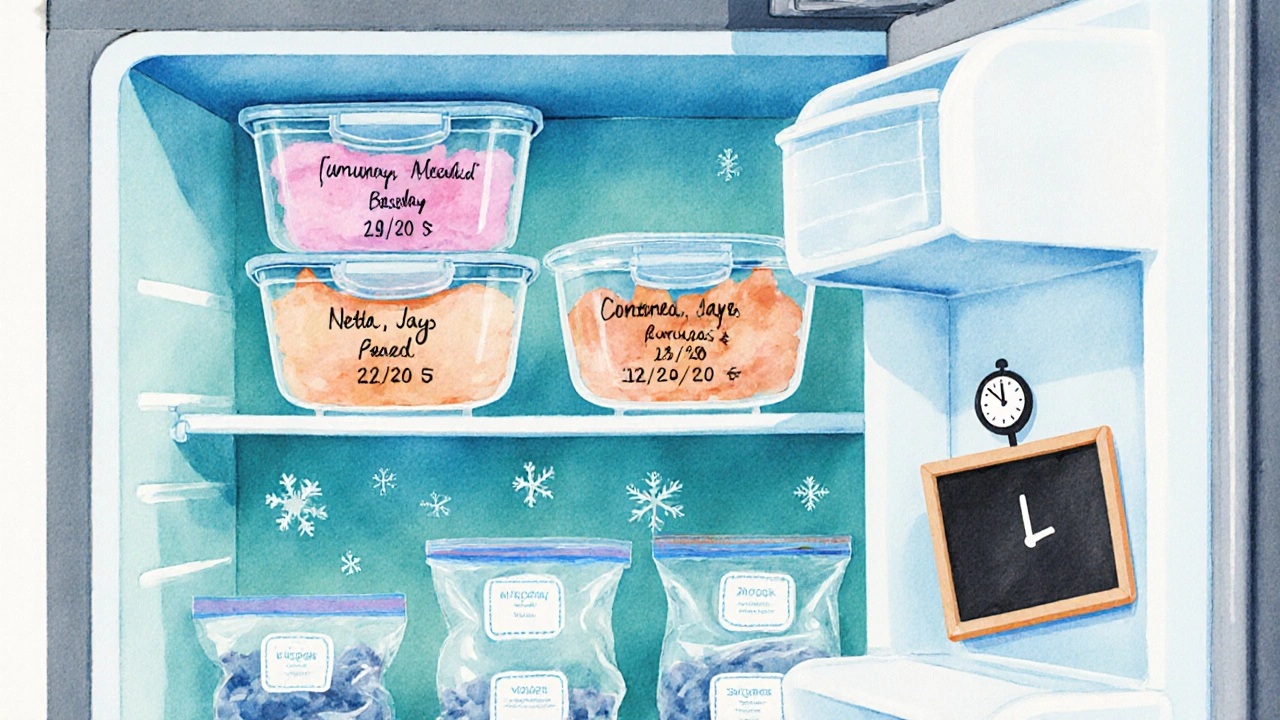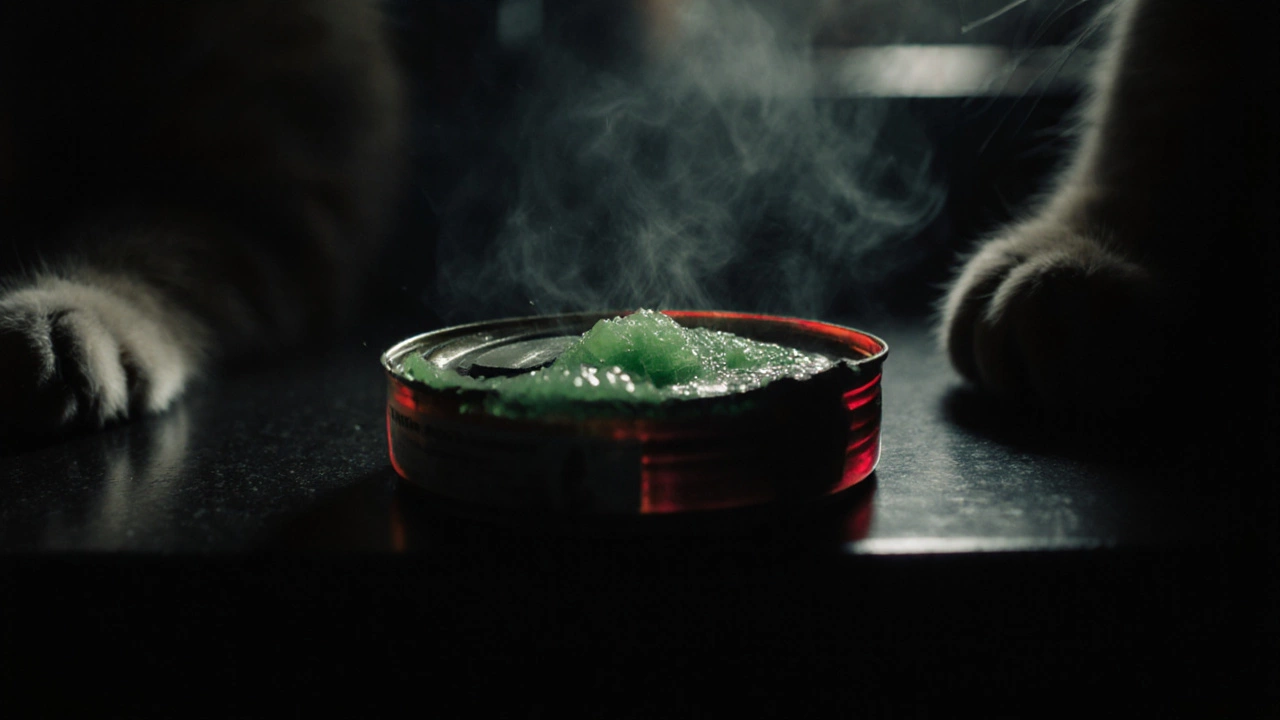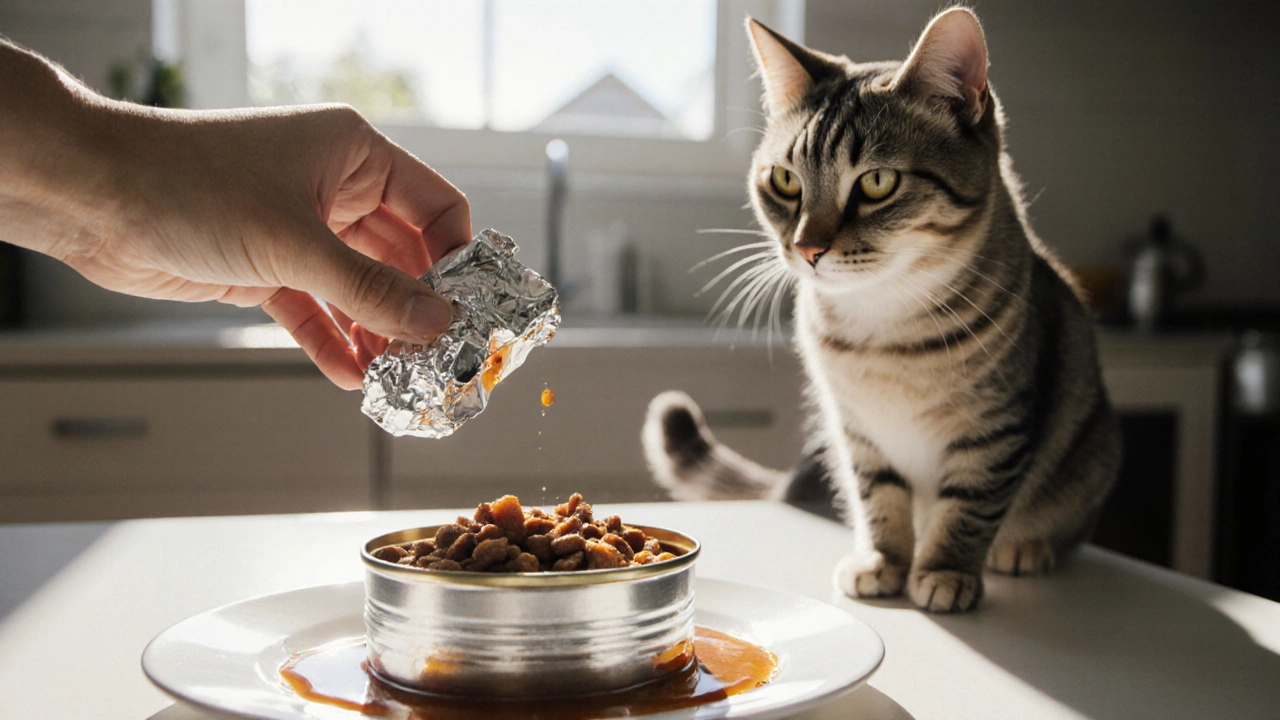Wet Cat Food Safety Timer
Calculate Safe Food Window
Enter when you opened the food and how it's stored to see when it becomes unsafe.
Safe Food
Food is currently safe for consumption.
Safe for 48 hours
Temperature Danger Zone
Food stored between 40°F (4°C) and 140°F (60°C) enters the temperature danger zone where bacteria can grow rapidly. This significantly reduces the safe consumption time.
Ever opened a can of wet cat food is a moisture‑rich cat diet packaged in cans, pouches or trays and wondered how long it stays good? Knowing the answer can save you money, keep your feline friend healthy, and prevent embarrassing odors in the kitchen. Below we break down the science of spoilage, the real‑world timelines for opened and unopened packs, and the exact steps you can take to keep every bite safe.
Why Moisture Changes the Game
Unlike dry kibble, wet cat food contains 70‑80% water. That high moisture level creates a perfect breeding ground for bacteria once the seal is broken. In the closed can, the environment is anaerobic - meaning oxygen‑loving microbes can’t thrive. The moment you pop the lid, oxygen rushes in, temperature drops (or rises) to kitchen levels, and the game changes.
Two key factors drive how quickly the food spoils:
- Temperature danger zone - typically 40°F to 140°F (4°C to 60°C). Inside this range, most bacteria double every 20‑30 minutes.
- Bacterial growth - common culprits include Salmonella and E. coli. Both can cause vomiting, diarrhea, or even serious infections in cats.
Unopened Shelf Life - The Manufacturer’s Promise
When you buy a sealed can, you’re looking at the "best‑by" or "use‑by" date printed on the label. That date reflects the point at which the manufacturer guarantees optimal flavor, nutrition, and safety, assuming the can stays intact and is stored at room temperature (around 68‑77°F / 20‑25°C).
Typical unopened shelf lives:
- Standard 3‑oz cans: 12‑18 months from production.
- Pouches (vacuum‑sealed): 8‑12 months.
- Fresh‑pack (refrigerated) trays: 5‑7 days, even before opening.
These numbers are industry averages from the AAFCO (Association of American Feed Control Officials) guidelines and the New Zealand NZ Food Safety Authority.
Opened Packs - Real‑World Timelines
Once you break the seal, the clock starts ticking. Below is a quick reference:
- Room temperature (68‑77°F / 20‑25°C): 2‑4 hours. After that, the risk of rapid bacterial growth climbs sharply.
- Refrigerated (33‑40°F / 0.5‑4°C): 24‑48 hours for most canned foods. Some premium, high‑protein formulas may last up to 72 hours if kept airtight.
- Freezer (0°F / -18°C): Up to 2 months. Thaw in the fridge, not on the counter, before serving.
The rule of thumb: wet cat food spoilage accelerates dramatically above 40°F. If you’re unsure, always err on the side of caution and discard any food that has sat out for more than two hours.

How to Spot Spoiled Wet Food
Even the most diligent cat owner can miss subtle signs. Here’s a checklist you can run through before feeding:
- Smell: A sour, fermented, or “off” odor is a red flag. Fresh wet food should have a mild meaty scent.
- Texture: Look for excessive liquid separation, curdling, or a slimy film on the surface.
- Color: Darkening, greenish tints, or patches of mold mean it’s time to toss it.
- Container integrity: If the can is bulging, dented, or the lid doesn’t seal properly, bacteria may have already infiltrated.
If any of these signs appear, discard the food immediately. The cost of a can is far less than a vet visit for foodborne illness.
Best Practices for Extending Shelf Life
When you’re serious about keeping wet cat food fresh, treat it like any perishable grocery item:
- Refrigeration: Transfer opened food to a shallow, airtight container. Metal cans can rust once opened.
- Portion control: If you feed small meals, consider splitting a large can into single‑serve containers and refrigerate them right away.
- Label dates: Write the opening date on the container with a marker. This visual reminder helps you stay within safe windows.
- Avoid cross‑contamination: Use a clean spoon each time you scoop food. Never double‑dip from the original can.
For those who buy in bulk, a simple freezer‑first approach works well: portion the food, seal it in freezer bags, and thaw only what you’ll serve that day.
Comparing Wet vs. Dry Cat Food Shelf Life
| Attribute | Wet Cat Food | Dry Cat Food (Kibble) |
|---|---|---|
| Moisture Content | 70‑80% | 10‑12% |
| Unopened Shelf Life | 12‑18 months (cans), 5‑7 days (fresh‑pack) | 12‑24 months |
| Opened Shelf Life (Refrigerated) | 24‑48 hours | 4‑6 weeks (sealed bag) |
| Storage Temperature | Room temp ≤ 77°F (25°C); fridge ≤ 40°F (4°C) | Room temp up to 95°F (35°C) |
| Typical Spoilage Signs | Sour odor, slime, discoloration | Stale smell, insect infestation |
The table shows why wet food demands more immediate attention. Dry kibble’s low moisture makes it far less prone to bacterial growth, but it can still go stale or attract pests.

What the Experts Say
Veterinary nutritionist Dr. Lisa Hammond (NZ Veterinary Association) advises: “If you’re feeding wet food daily, treat each can as a perishable item. Store it in the fridge promptly and discard after 48 hours. Cats are surprisingly sensitive to spoiled protein, and the resulting gastrointestinal upset can be severe.”
The Pet Food Safety Guidelines from the U.S. FDA also recommend the “2‑hour rule”: never leave pet food out at room temperature for longer than two hours, and always refrigerate leftovers within that window.
Quick Takeaways
- Unopened wet cat food lasts 12‑18 months if stored at room temperature.
- Once opened, keep it refrigerated and use within 24‑48 hours.
- Never leave wet food out for more than two hours at room temperature.
- Watch for sour smell, slime, or discoloration as spoilage clues.
- Use airtight containers, label opening dates, and freeze portions for longer storage.
Frequently Asked Questions
Can I feed my cat wet food straight from the can without refrigeration?
If the can has just been opened and you’re serving the food within two hours, it’s generally safe. After that, bacterial growth can start, so move the leftovers to the fridge.
Is it okay to freeze wet cat food?
Yes. Freezing preserves freshness for up to two months. Thaw the portion in the refrigerator, not on the countertop, to keep it below the danger zone.
My cat seems fine after eating smelly wet food-should I still throw it out?
Yes. A cat’s tolerance doesn’t guarantee the food is safe. Consuming spoiled protein can lead to hidden gut inflammation or later illness.
What’s the difference between “best‑by” and “use‑by” dates on wet cat food?
“Best‑by” is about quality - flavor and nutrition. “Use‑by” is a safety deadline. For wet cat food, treat both as the same; discard after the date if the can is damaged or opened for long.
Do all wet cat foods spoil at the same rate?
No. Higher protein or fish‑based formulas provide more nutrients for bacteria, so they can spoil faster than simple meat‑based varieties.
Keeping wet cat food safe isn’t rocket science; it’s about respecting temperature, timing, and hygiene. Follow the guidelines above, and you’ll keep your cat’s meals tasty and your kitchen odor‑free.
